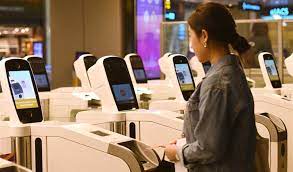
Starting Monday, some travelers arriving at Singapore’s Changi Airport will no longer need to present their passports for immigration clearance. This is part of a pilot program where Singapore residents arriving at Terminal 3 can use biometric identification, such as eye and facial recognition, instead of traditional passports, as announced by the Immigration & Checkpoints Authority. The term “residents” includes citizens, permanent residents, and long-term pass holders. The initiative will expand to all Changi Airport terminals by September and to Seletar Airport and Marina Bay Cruise Centre by December 2024.
Eligibility for this new system extends to Singapore residents, who can bypass passport checks at both air and sea entry points. Foreign visitors can also participate, but only when departing Singapore, and they must register their biometric data—iris, facial, and fingerprint—at manual immigration counters. However, children under six are not eligible for biometric or automated lane clearance.
This shift towards passport-less immigration is part of Singapore’s “New Clearance Concept,” introduced in May, which aims to modernize and automate border control. This initiative marks a significant change from traditional passport checks, a process Singapore has been gradually phasing out. By early 2026, officials anticipate that 95% of travelers will use automated lanes, with the remaining 5% being ineligible groups like young children. Despite some resistance to biometric processing, authorities believe it will enhance border security and improve the travel experience by reducing wait times by 40%.
Sumesh Patel, Asia-Pacific president of SITA, mentioned that around 85% of airports will adopt some form of biometric processing within the next three to five years. Singapore’s biometric-only processing is the second type of passport-free clearance available. In May, the country introduced self-generated QR codes for travelers at two land checkpoints connecting Singapore and Malaysia. These QR codes are necessary at land borders due to the lack of advance notice of travelers’ movements.
Both biometric and QR code systems are part of Singapore’s broader efforts to modernize border control to handle increasing traveler numbers and address challenges posed by an aging workforce.